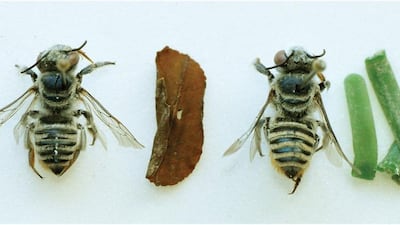DUBAI // A bee using green plastic instead of leaves to build a nest has highlighted the impact of discarded human rubbish on wildlife.
Researchers said the discovery of a female leafcutter bee at Dubai Desert Conservation Reserve using near-identical short, narrow strips of plastic was “quite surprising”.
Typically, the bees use pieces of leaf for the construction of a brood cell, the structure in which pollen and nectar is stored and an egg laid.
The study was conducted by Dr Sarah Gess of Albany Museum and Rhodes University, South Africa, and Peter Roosenschoon, a conservation officer at the reserve, which lies about 65 kilometres from Dubai city, and a co-author of a paper on the findings.
“Plastic rubbish is part of our environment right now, which sometimes gets confused for leaves,” he said.
The bee involved, Megachile patellimana, belongs to the Megachilinae subfamily.
In the paper, the senior author, Dr Gess, and Mr Roosenschoon said the “tough green plastic” strips were “clearly a substitute for leaves”.
They describe how a female bee was captured while carrying into a burrow in the bank of an irrigation furrow a plastic strip about 10mm long, 2mm wide and almost 1mm thick, while a further half dozen similar strips were found in the nest “grouped together in an apparent attempt to construct a cell”.
“The cutting of the tough plastic would have been possible by using the large, robustly and acutely toothed mandibles [jaws],” the authors wrote.
Using plastic instead of leaf is probably not a good thing in terms of producing a nest that functions well.
“It’s unlikely the bee would’ve been able to make a cell using these narrow, stiff pieces of plastic,” said Dr Gess.
Although describing the use by bees of plastic as “very unusual”, she said that it had been recorded before. In one case in Canada, fragments of plastic bags were used. These, being flexible and therefore able to be folded around to form proper cells, would probably have been “a better substitute for leaves” than the rigid plastic in the UAE study.
The use of artificial materials is seen more widely in the animal kingdom, said Mr Roosenschoon.
“There’s a lot of rubbish in the area. It was a big surprise the bees will take it but, on the other hand, other animals use plastic to make their nests – birds do it, rodents have been known to carry plastic to their burrows,” he said.
The researchers are unsure where the green plastic came from, although a nearby camel farm is one possible source.
Another female M patellimana bee carrying, as expected, a leaf piece was captured at a different site in the reserve where it was nesting in compacted sand at the base of a plant.
The nesting behaviour of two other Megachilinae species, both in galleries above ground and constructing their cells from resin and sand, are also described in the study, which is published in the Journal of Hymenoptera Research. As well as bees, the Hymenoptera order of insects includes sawflies, wasps and ants.
As knowledge of the nesting behaviour of the three species featured in the paper was fragmentary, the paper contributes to a better understanding of the evolutionary relationships of megachiline bees.
Fieldwork for the study was carried out in April and May 2015, although the details of the nesting behaviour have just been published in the paper, titled Notes on the Nesting of Three Species of Megachilinae in the Dubai Desert Conservation Reserve, UAE.
Last year, the same authors published a more substantial paper, also in the Journal of Hymenoptera Research, on the flower visiting patterns in bees and wasps in the reserve.
newsdesk@thenational.ae


